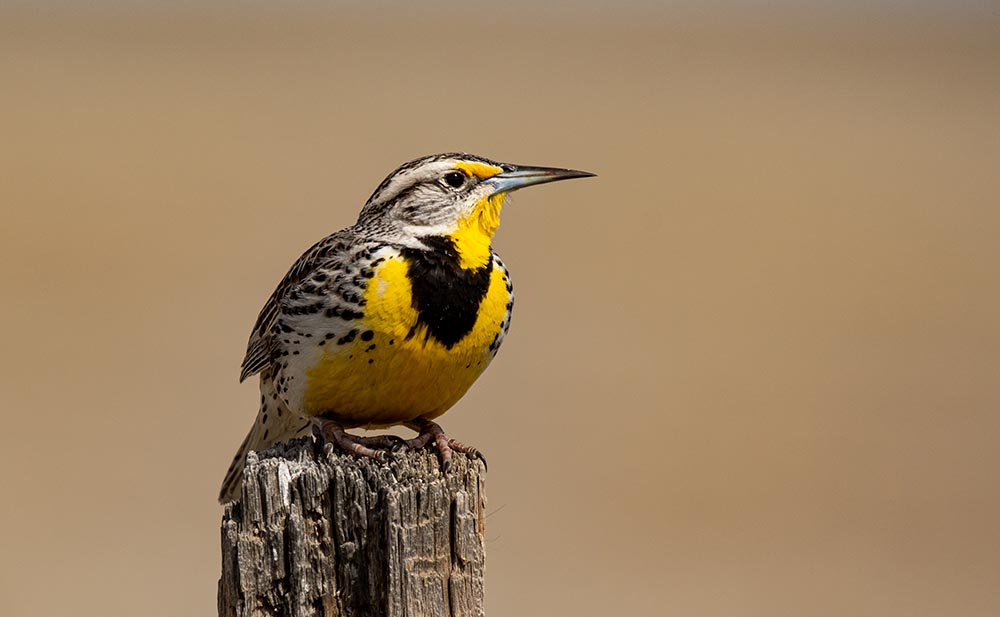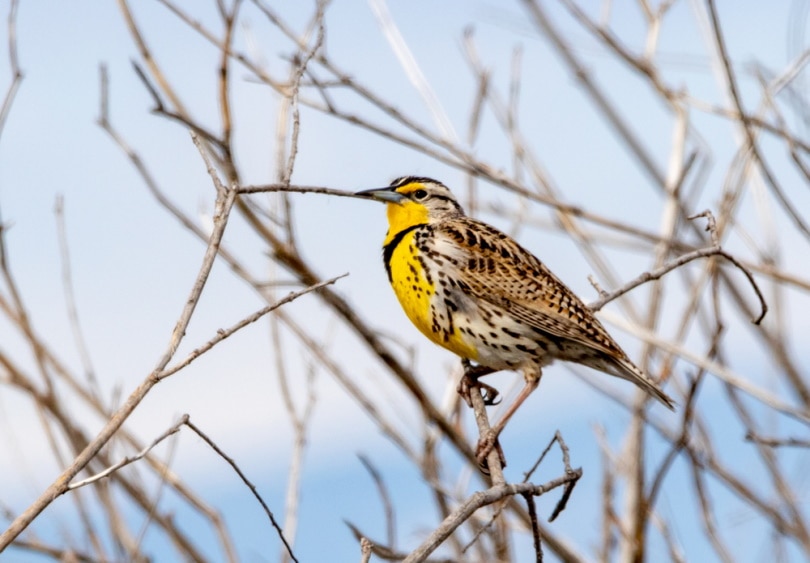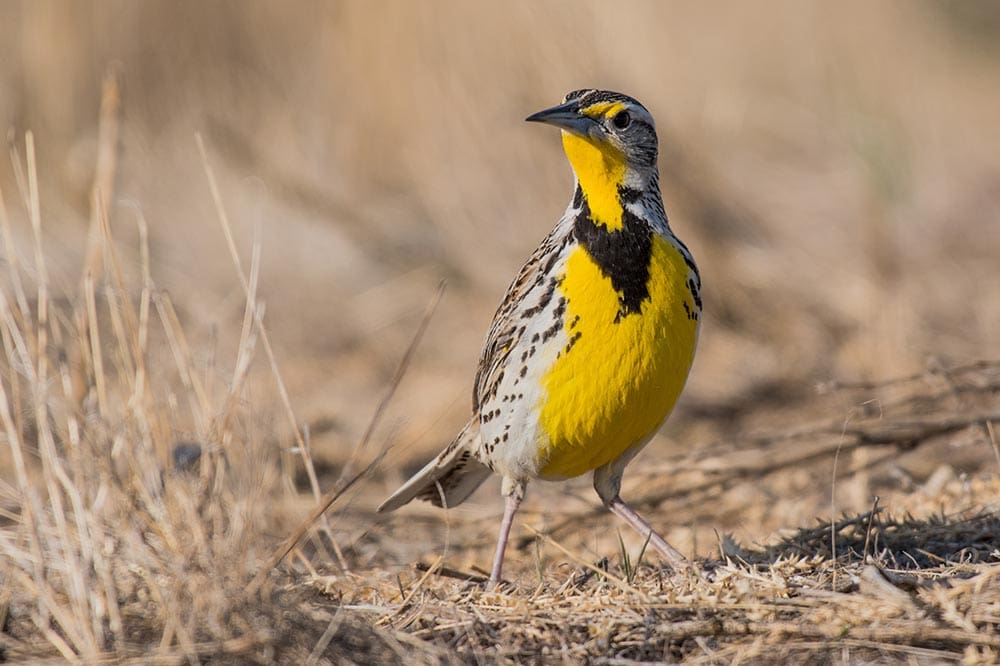What Is Montana’s State Bird? How Was It Decided?
Last Updated on

All 50 states have their own state bird, and each of those state birds has its own story and history. Montana is no different. It adopted the western meadowlark as the state bird all the way back in 1931, and it’s an interesting story.
We dive into it all for you here, provide you with a few insights into the western meadowlark, and even give you a few tips to try to attract these beautiful songbirds to your backyard!

What Is Montana’s State Bird?
Montana’s state bird is the western meadowlark, a small songbird with a yellow underbody and a patterned brown appearance on the backside and wings.
With intricate songs and a beautiful appearance, it is a favorite for bird watchers.
The western meadowlark eats insects, grains, and weed seeds, and unlike other birds that nest in trees, the western meadowlark prefers to build its nest right on the ground. Therefore, a wide array of predators like to come after them, including hawks, crows, coyotes, weasels, raccoons, and skunks!

How Did Montana Pick Its State Bird?
Montana named the western meadowlark as its state bird back in 1931. Five other states (Wyoming, Oregon, Kansas, Nebraska, and North Dakota) have it as their state bird too.
The way that Montana chose the western meadowlark is quite unique. The state assembly held a state vote, but the only people voting were school children.
The children picked the western meadowlark, the state assembly went with their decision, and the western meadowlark has been Montana’s state bird ever since.
Is the Western Meadowlark Endangered?
While their population is starting to decline, there are still tons of these birds around. Experts estimate that their population numbers are over 30 million, and the IUCN lists them under the category of “Least Concern.”
So, while there might be fewer western meadowlarks around in the future, it doesn’t seem like these beautiful songbirds are going anywhere any time soon!
The Western Meadowlark’s Range
While the western meadowlark is the state bird of Montana, it only appears in the state during the warm months. It migrates up to Montana and even into parts of Canada to breed.
These birds are permanent residents from California to parts of Oklahoma, and they’ll venture farther east during the non-breeding season. However, they don’t travel farther west than Louisiana during the warm months of the year.
However, according to Audubon, with a warming climate, the range of the western meadowlark will likely consolidate into the more central region of the United States.
In fact, while most of Montana will still have the western meadowlark around in the state, there’s a good chance that a portion of the state will no longer have the western meadowlark visiting.

How Do You Attract Western Meadowlarks?
If you’re trying to attract a western meadowlark to your backyard, you’re in for a challenge. About 80% of a western meadowlark’s diet consists of insects. So, you can’t just put out the right kind of feeder and expect one to come.
Complicating the matter is that the western meadowlark builds its nest on the ground. This makes it a challenge to maintain your lawn if you have a western meadowlark in your backyard because the last thing that you want to do is destroy their nest while mowing!
While it’s not the easiest to attract these birds to your backyard, there are a few things that you can do to try:
- Put out a feeder with grass seeds.
- Put out a bird bath.
- Provide plenty of areas for a western meadowlark to perch.
- Provide plenty of open spaces.
Finally, keep in mind that the western meadowlark isn’t a year-round resident if you’re in Montana. So, even if you do everything right, during the cold months, you’re not going to see any western meadowlarks in your yard!
Even if you don’t get a western meadowlark to visit, if you set up your backyard this way, you’re going to get plenty of other songbirds coming to check out and nest in your yard.

Final Thoughts
With such a beautiful appearance and an aesthetically pleasing sound, the western meadowlark isn’t only the state bird of Montana but also one of the most loved birds on the western side of the United States.
So, whether you’re just visiting Montana or you live there, keep an eye out for this small yellow-and-brown songbird while you’re there. If you’re lucky enough to spot one, it’s a treat that you won’t soon forget!
Featured Image Credit By: Kerry Hargrove, Shutterstock
About the Author Robert Sparks
Robert’s obsession with all things optical started early in life, when his optician father would bring home prototypes for Robert to play with. Nowadays, Robert is dedicated to helping others find the right optics for their needs. His hobbies include astronomy, astrophysics, and model building. Originally from Newark, NJ, he resides in Santa Fe, New Mexico, where the nighttime skies are filled with glittering stars.
Related Articles:
What Is the Best Binocular Magnification for Hunting? Optical Features Explained
10 Types of Hummingbirds in Arkansas (With Pictures)
8 Types of Hummingbirds in Nebraska (With Pictures)
5 Types of Hummingbirds in Idaho (With Pictures)
3 Types of Hummingbirds in Mississippi (With Pictures)
8 Types of Hummingbirds in Kansas (With Pictures)
5 Types of Hummingbirds in West Virginia (With Pictures)
5 Types of Hummingbirds in Ohio (With Pictures)
